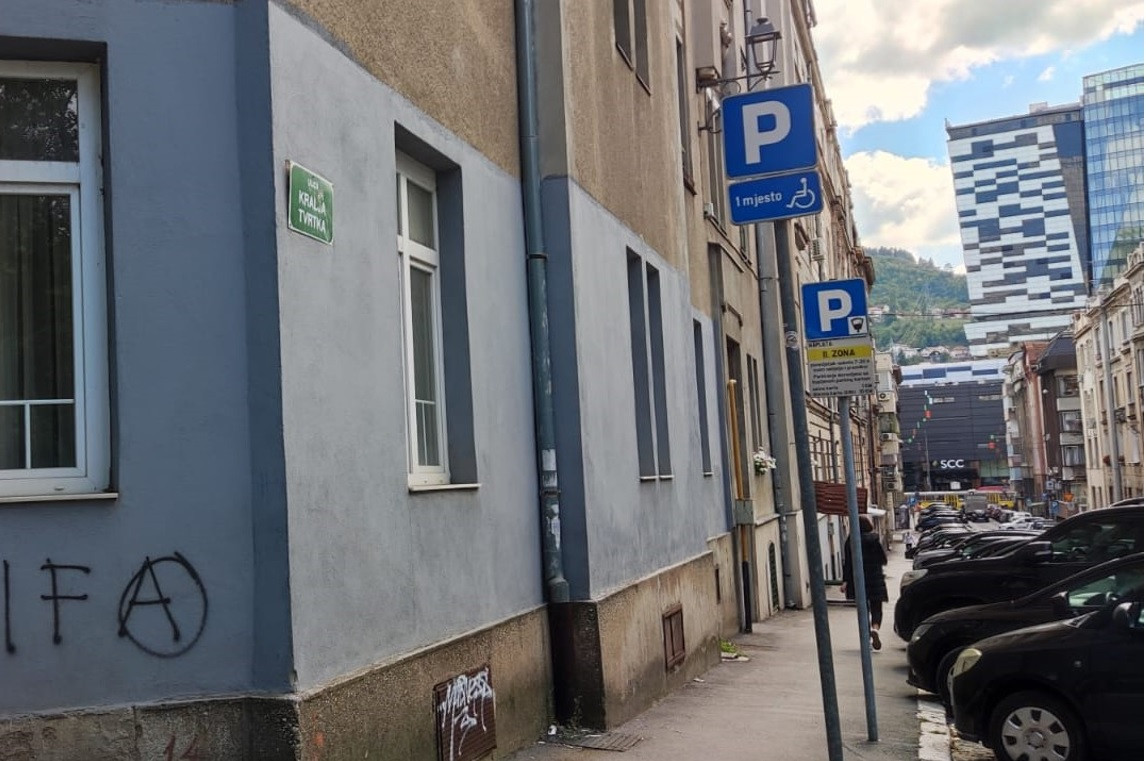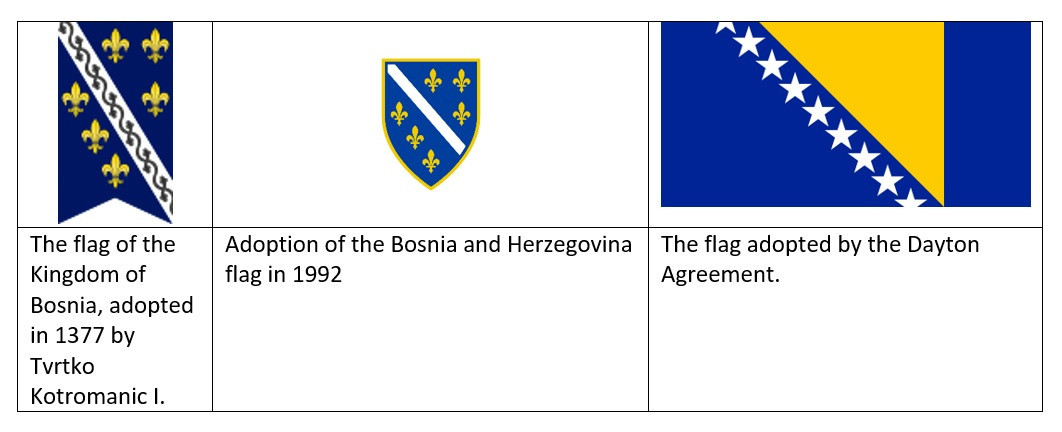Bosnia's King Tvrtko: The story of a monument and 'kissing the future'
A Sarajevo sculpture has reignited the agenda in Bosnia and Herzegovina. However, the opening film of the Sarajevo Film Festival had the phrase "Kiss the future." It appears that no aspect of the past is immune to the disease of nationalism in Bosnia and Herzegovina.
Özgür Dirim Özkan
A week of heated debate in Bosnia and Herzegovina pushed everything off the agenda. When the mayor of Sarajevo, Benjamina Karic, suddenly erected a statue of King Tvrtko I, who ruled the mediaeval Bosnian Kingdom, in front of the Presidential Palace, controversy ensued. Before we examine the process, let's briefly review its history.
In 958, the name "Bosona" appeared for the first time in a book written by Byzantine Emperor Konstantinos Porphyrogennetos. In 1139, after Hungary seized the region, the Banate of Bosnia was established under the Hungarian rule. The misfortune of the Bosnian Banate, which was declared independent by Ban Kulin in 1180, begins with the establishment of the Bosnian Church in 1189. Although it is a matter of debate among historians and scholars, the Bosnian Church has cosmological relations with Bogomilism, which was partially spread in the Balkans in those years. The Bosnian Church, which rejects the institutional structures between God and man, and therefore does not accept the church or clergy, has been condemned as "heretical" by both the Catholic Church and the Eastern Orthodox Church. There was even a Crusade against Bosnia in the 13th century, but the Mongol invasions prevented its completion.
During that time, some easterners who held beliefs that were strikingly similar to those of the Bosnian Church had arrived to Bosnia. These people were Bektashi missionaries. Bektashism emphasizes the spiritual and mystic aspects of Islam, incorporating Shia Islam, Sufism, and Turkish folk traditions. The Bektashi Order has its own rituals, practices, and teachings, as well as a distinct spiritual path. The order is well-known for its inclusive and tolerant stance, which promotes love, equality, and respect for all people. Similar to the Bosnian Church, Bektashis also rejected a religious hierarchy between God and believers. In addition, Bektashi leaders (dedes, alperens, gazis) were good in warfare, proficient in using swords. The initial steps of Islamization in Bosnia occurred nearly two centuries before the Ottoman hegemony. After feudal elites accepted the Ottoman religion, the operation was concluded.
In 1322, another event that altered the course of Bosnian history occurred. The Kotromanic dynasty seized control of the Banate of Bosnia and continued as a Kingdom until 1463, when the Ottoman Empire took over the region. King Tvrtko I was one of the most brilliant monarchs during the approximately 250-year Kotromanic period. Tvrtko Kotromanic expanded the borders of the Bosnian Kingdom as he struggled against increasing Ottoman and Hungarian pressure. During the reign of Tvrtko I, the Kingdom of Bosnia ruled over the entirety of Bosnia, a significant portion of Croatia, and portions of today’s Serbia and Montenegro.
Bosnia-Herzegovina, which declared independency in February 1992, can be said to have derived its national identity from the Ottoman heritage rather than the mediaeval Kingdom of Bosnia. In fact, this reference was also an affirmation of the right-wing Serbian historical narrative that Bosnians were originally Serbs who converted to Islam during the Ottoman period. In exchange, the existence of the mediaeval Kingdom of Bosnia was evidence that Bosnian national identity existed prior to Ottoman rule.
In recent years, particularly on the political level, discussion of the Kingdom of Bosnia has grown in popularity.
Benjamina Karic, who was elected mayor of Sarajevo in April 2021 as the social democratic candidate, is also known for her parallel statements. Karic, of Jewish (Sephardic) origin, is 30 years old and has won the post by winning a victory over the candidate of Izetbegovic's party, SDA. She is well-known for her successful diplomatic relations and efforts to make Sarajevo a major city in the region. One of the most important of these relationships is the establishment of a very close partnership with Ekrem İmamoğlu, who defeated the candidate of the ruling AKP of President Recep Tayyip Erdoğan to win the mayorship of Istanbul Metropolitan Municipality in 2019. In fact, the mayor of SDA, Abdulah Skaka, has signed an important scandal by refusing to welcome İmamoğlu, who visited Sarajevo in 2019. In addition, it is known that Karic also gives special consideration to the historical heritage of socialist Yugoslavia as well as the mediaeval Bosnian Kingdom, where both were neglected during the SDA period.
Just at this conjuncture, Karic commemorated the 645th anniversary of I. Tvrtko's coronation on her social media accounts on October 26, 2022, and announced that a statue of I. Tvrtko Kotromanic would soon be erected in the capital. This sparked the discussion.
Nationalists from Serbia, renowned for their skill in distorting and manipulating history, could not sit idle. The Serbian nationalists, who went so far as to argue that the true Srebrenica massacre was perpetrated against Serbs and were able to persuade Nobel Prize-winning author Peter Handke, should have also addressed this issue. They immediately disclosed through their "documents" (!) that the Kotromanic dynasty was of Serbian descent. Drasko Stanivukovic, the mayor of Banja Luka, the capital of the Bosnian Serb Republic (Republika Srpska), announced last May that the name of Gajeva Street in Banja Luka will be changed to King Tvrtko Kotromanic I Street and they will erect a statue of Tvrtko Kotromanic I in the city. Karic maintained her composure in the face of this news and expressed her delight that mediaeval Bosnian history will finally receive the recognition it deserves in all over Bosnia and Herzegovina. Furthermore, since there is a King Tvrtko Street in the capital city, why not to erect one more in Banja Luka?

Here, we must open a parenthesis. Bosnia and Herzegovina, which declared its independence in 1992, adopted the six-gold-lily flag (fleur de lys) of the Kotromanic dynasty as its national flag. During the Dayton negotiations, the Serbs argued that this flag only represented Bosniaks, so they accepted the EU's design. Serbs, who a quarter of a century ago rejected the flag of the Kotromanic dynasty on the grounds that it "represents only Bosnians," are now rushing to portray the Kotromanic dynasty as "originally Serbs."

Three times, the National Commission for the Protection of Monuments denied Benjamina Karic's application to erect a statue of King Tvrtko I in Sarajevo. It comes as no surprise that the reason for this refusal was the Serbian member of the commission's veto. The sculpture by Professor Stijepo Gavric of the Faculty of Fine Arts at Sarajevo University was placed in front of the Presidential Palace of Bosnia and Herzegovina on the night of August 28 thanks to Karic's deft maneuver. The statue bearing the inscription "Bosnian King Tvrtko Kotromanic I 1338-1391" was erected on the 834th anniversary of the publication of the "Ban Kulin Charter" which is considered as the first document regarding the sovereignty of Bosnia.

Karic stated that nighttime was preferred to avoid traffic during the day and that the statue, which did not receive permission from the commission of monuments three times, was placed "temporarily" as part of an exhibition, adding that the Eiffel Tower is still "on display" in Paris with the same status.

The debate on this has been going on for a week in Bosnia. It will probably continue further. But the statue has already become the center of attention of Sarajevo people.
---
The 29th Sarajevo Film Festival, the first of which was held in 1995 under bombs during the Siege of Sarajevo, was held this year from August 11-18. "Kiss the Future" served as the festival's opening film. This documentary film, which focused on the Siege of Sarajevo and the people under siege was based on U2's concert at Kosevo Stadium in 1997, immediately after the siege of Sarajevo, reflected not only the concert but also the daily life and cultural life in a besieged city. It was an unforgettable gesture for U2 to connect live with Sarajevo before each concert on their Zooropa tour in 1992-1993 and to give a voice to the besieged citizens of Sarajevo. More than a thousand moviegoers cried while viewing these scenes in the documentary. In June 1992, the words of a young woman connecting from Sarajevo before a concert in Sweden almost illuminated our day.
"Sarajevans are not afraid of the war, but of what will happen after the war."
We can say that what was feared has happened. Sarajevo has not fully recovered from the war. We are discussing a country where corruption, mafia, and political crises are prevalent due to the dominance of nationalist politics and the Dayton Accord, which restricted politics to ethnic borders serves as a means of dividing the nation.
A native of Sarajevo stated in a recent interview for the documentary: "We need this concert now more than we did in 1997." We do not know if resurrecting the historical heritage of the Mediaeval Kingdom of Bosnia and elevating the historical heritage of Bosnia above ethnic identities will help Bosnians who have lost all hope in Bosnia to once again look to the future.
Enes Zlatar, the founder of the Sarajevo punk-rock band Sikter (The Word derives from Turkish phrase meaning “f.ck off”), who performed before U2 at the 1997 concert, appeared on stage just after the screening of the documentary in Sarajevo Film Festival, wearing a t-shirt written "F.ck the past"…
"F.ck the past, kiss the future"...
It is still unknown whether Sarajevo will be able to do the second; kiss the future, and make peace with the future, but we do know that he continues to struggle with history's curse.
